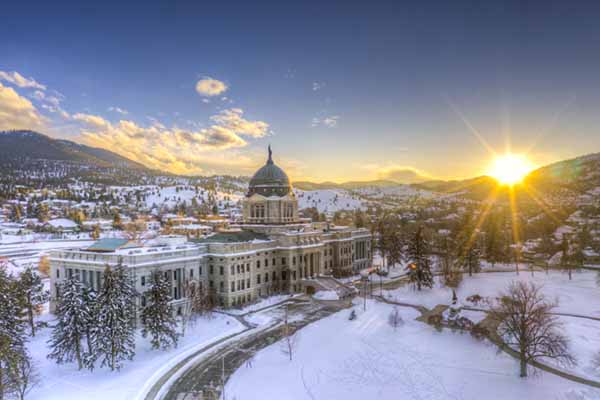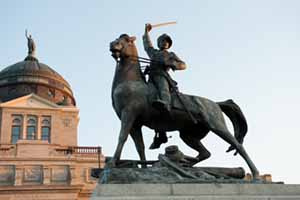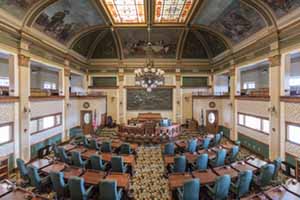Montana State Capitol Building
Updated: August 7, 2020

Before Montana was a state, it was a United States Territory. The city of Helena became the territorial capital in 1875. Montana gained statehood in 1889. In 1894 Montana voters chose Helena in a controversial statewide election. The Montana Legislature voted to spend almost half a million dollars on a state capitol building and construction began in 1899. The state Capitol building was opened for use on the Fourth of July, 1902.
The story of the Capitol building really begins at the top, with the "Goddess of Liberty," as she has been known for 100 years. It's the statue that stands on the copper dome outside. When Anaconda and Helena were fighting over which city would become the state capital, the men responsible for designing and building the Capitol building ran off with all of the plans and records.
During the construction of the Capitol, a statue arrived by railroad from a company back east. Nobody knew what it was for or who had bought it. The statue company's records were destroyed in a fire, and for 100 years nobody knew for sure why the Goddess of Liberty was made, who sclupted her, or if 'Liberty' was her name. The Capitol builders wanted a statue for their dome so they used this one.
In 2006 a descendent of the sculptor contacted the Montana State Historical Society wanting to know if her grandfather's statue still stood atop the state Capitol. The original sculptor of the statue atop the Montana State Capitol was Edward J. Van Landeghem, and he had named his sculpture 'Montana,' not 'Liberty.' After a century of being misnamed we now know Montana stands atop the State Capitol.
Copper played a big part in Montana history. In fact, the political battle between Anaconda and Helena for selection as capital city was stirred up by two men who had made millions of dollars by mining copper. Daly wishing to gain political advantage in his mining ventures supported Anaconda and Clark wishing to thwart Daly promoted Helena. Each Copper King used the newspapers they owned to convince the public to vote for their city. In this hotly contested struggle there were allegations of bribery and counterfeit ballots.

A statue of a man on horseback with sword raised was added in 1905. It stands in front of the Capitol and depicts Civil War Union general Thomas Francis Meagher. In 1864 he took over as governor of the Montana Territory while the governor was away. He wrote an early constitution for Montana, hoping it would be used if Montana became a state. He mysteriously drowned while waiting for a shipment of guns on a riverboat at Fort Benton on the Missouri River.
Only a few years after the Capitol was finished (1902), Montana's government had outgrown it. Between 1909 and 1912, new wings were added to both ends of the building.

Like the United States government, Montana's legislature has two houses, a senate and a house of representatives. The state government also has three branches like the federal government. The Capitol was enlarged to make more room for the executive (the Governor), judicial (Montana Supreme Court), and the legislative (Senate and House of Representatives) branches. The first thing visitors see inside the building is the massive rotunda — or the curved inside of the dome outside — right above their heads.
Huge columns and colorful paintings decorate the main area. Around the rotunda are four round paintings showing four important kinds of people in Montana's early history. The native American, the explorer, the gold miner, and the cowboy were painted for the Capitol opening in 1902. Off to the sides, two large hallways lead to the Governor's office on one end, and the Secretary of State's office on the other. Straight ahead, the Grand Stairway leads up to a large window of colorful stained glass.

Down one hall, past the Governor's Office, is the Governor's reception room. The Governor meets with important visitors and representatives here at the large table in the center of the room. There is a secret door to the right of the fireplace on one end of the room. The Governor can use it to enter the room straight from his office. A portrait above the fireplace is of Joseph K. Toole, the first Montana state governor. A picture at the other end of the room is of Wilbur Fisk Sanders. Before Sanders became one of Montana's first United States senators, he had been a vigilante in Virginia City. In 1865 Sanders had settled Helena's argument with nearby Silver City over which place would be the county seat (capital city of the county). He rode from Helena to Silver City and took all their official records back to Helena. Silver City later became a ghost town.
One of the Capitol's main attractions is a giant painting by Montana's famous Western artist Charles M. Russell. The painting, called "Lewis and Clark Meeting Indians at Ross' Hole", is 25 feet long (like three cars end-to-end) and twelve feet high. It depicts the scene where the explorers Lewis and Clark asked Montana's Salish Indians for the safest route to cross the mountains to the Pacific Ocean. The canvas on which it's painted was so big that the artist had to have the roof raised on his studio to paint it. It's displayed above the Speaker's chair in the House of Representatives' chamber.

Near the center of the Capitol, up the Grand Stairway and on the second floor, is a statue of Jeannette Rankin. She was the first woman in America to be elected (1916) to the U.S. House of Representatives.
The Capitol is over 100 years old. Workers have restored the Capitol in time for its centennial celebration. Changes were made to the building so state government will be able to work better, but the main idea was to bring back the look the Capitol had when Montana was a new state.
The multi-million dollar renovation of the century-old structure, which still serves as an office building began in 1997. Extensive interior repairs included restorations and renovations, including new wiring for computers. It reopened for the 2001 legislative session beginning in January, 2001.
Visit the state Captitol building.
Montana State Capitol Campus Historic District
Updated: August 7, 2020

